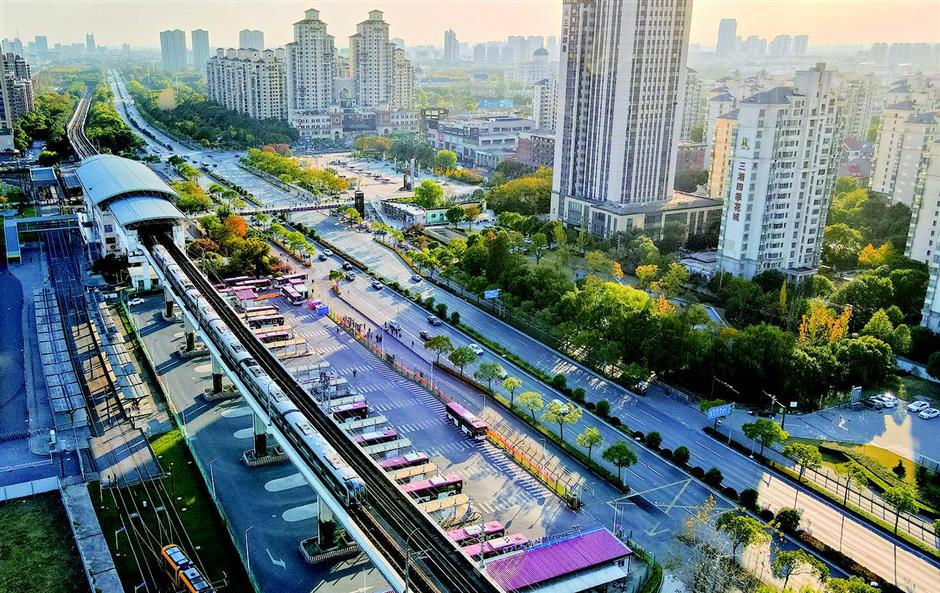Songjiang develops major traffic hub with extensive transport network

Along the Songjia Road S., the buses, trams and Metro trains have formed a busy traffic scene.
Songjiang District sprints all out to built itself into a transportation hub for Shanghai as well as the Yangtze River Delta region.
With the recent construction of the western extension of Metro Line 12 and the Husong High-speed Road project, Songjiang shows its ambition to set up a traffic transit center with four networks – national high-speed railway, Metro lines, tramcars and ground public transport.
The primary goal of the district is the idea of "30, 45, 60," allowing Songjiang residents to travel to the surrounding central towns within 30 minutes, 45 minutes to cities near Shanghai, and 60 minutes to international hubs.

Songjiang South Railway Station
National high-speed railway
The country's high-speed railway has incorporated Songjiang into its national system. According to the "2035 Shanghai" plan, Songjiang South Railway Station has been confirmed to be the departure station for the new Shanghai-Suzhou (Jiangsu Province)-Huzhou (Zhejiang Province) High-speed Railway.
At the same time, the Songjiang South Railway Station has also been upgraded to a city-level terminal, which will be expanded from the current two platforms and four tracks to nine platforms and 23 tracks, becoming the third largest high-speed railway station in Shanghai after Hongqiao and Shanghai East (Pudong). It is predicted that the station will receive over 20 million passengers per year.
The Shanghai-Suzhou-Huzhou High-speed Railway is set to be completed by the end of next year, and the Shanghai section is currently under construction. In November, the cable-stayed bridge's continuous beam of the railway over the Xietang River in Songjiang was connected, and 20 days later the bridge's final main tower was roofed.
A comprehensive transportation system is emerging, which interlaces national railway, intercity coach, subway, tram, bus, taxi, private car and others.
Supported by Songjiang's crisscrossed canals and highways, the district is forging ahead to build a portal logistics center for the international high-end supply chain in the Yangtze River Delta region.

The cable-stayed bridge for the Shanghai-Suzhou-Huzhou Railway
Metro lines
Metro Line 9, launched in 2007, was the first underground line that reached Songjiang. Statistics shows that in 2022 the line's daily riders in the Songjiang section reached 270,000 persons, and the Jiuting Station received 67,818 passengers on average.
But the map also shows that there are currently no transfer stops with other Metro lines among the 13 consecutive stations from Songjiang to downtown Shanghai. The subway compartments are always crowded during the morning rush hours.
Now, with the commencement of the western extension project of Metro Line 12, this awkward situation will finally come to an end.
The extension project, about 17.27 kilometers long, all underground, is designed to cross two districts, Minhang and Songjiang. It will begin at Qixin Road, the current western terminus of Line 12 in Minhang, and stretch six more stations, to Dongjing Station in Songjiang.
Dongjing will be a transfer stop for Line 9 when the extension is finished.
With a total investment of 16 billion yuan (US$2.36 billion), the project is scheduled to be finished by 2027. The maximum speed on the line is designated to reach 100 kilometers per hour. Among the six news stops, the largest spacing is 5.23 kilometers, and the shortest is 1.49 kilometers.
The Metro line will definitely invigorate Songjiang's northeast development as construction of new shopping hubs, commercial centers and high-end neighborhoods is under way along the line.

The bright yellow tramcar is the first low-floor tram in the city.
Urban tramcars
The tramcar system has been a strong boost to the district's public transportation network since it was put into full operation at the end of 2019. The current two lines T1 and T2 add up to 31.24 kilometers in total length.
By November, tramcars had run 387,131 times with a departure punctuality rate of 99.62 percent. They offered service to more than 28 million passengers with over 20,000 daily riders.
Produced by Shanghai Rail Traffic Equipment Co, the 33-meter-long, silkworm-shaped tramcar, is bright yellow. It is the first low-floor tram that has no stairsteps between the platform entrance and the passenger cabin. It has the capacity to carry 300 people at a maximum speed of 70 kilometers per hour, 5 kilometers faster than conventional buses.
T1 and T2 tramcar lines have their own tracks respectively.
The T1 line runs 15.6 kilometers with 23 stops. It starts at Canghua Road, traveling along Dongxing, Lianyang, Xinzhen and Xinzhan roads to its terminus at the Xinqiao Railway Station.
T2, with 36 stops, runs in a loop which starts and ends at the Songjiang University Town. The 24.3-kilometer line goes through downtown Songjiang, connects the Thames Town, and passes by the Songjiang Sports Center.
The second phase of T2 line is scheduled to start this year, and the first construction phase of T4 has reached blueprint stage.

Public buses in Songjiang are all equipped with GPS and cameras, making it convenient for passengers to check the real-time information for each bus.
Ground public transport
Public transport is still the first choice for most Songjiang residents. By the end of 2021, the district's 84 villages had been all linked by bus lines. Every 500 meters, there is a bus stop in Songjiang's downtown areas.
The buses are all equipped with GPS and cameras, and passengers can simply check on the app to get real-time information for each bus. More than 480 bus stops are installed with electric stop boards that update the buses' departure and arrival time.
Bus commuting is also a way of green, low-carbon lifestyle.
By the end of last year, more than 85 percent of Songjiang's buses were electric-powered, and it will reach 95 percent by 2025.
In the next three years, Songjiang will update 60 percent of its buses to have platform-level floors, a service for the special groups of the elderly, pregnant women and people who have physical disabilities and infirmities.
















